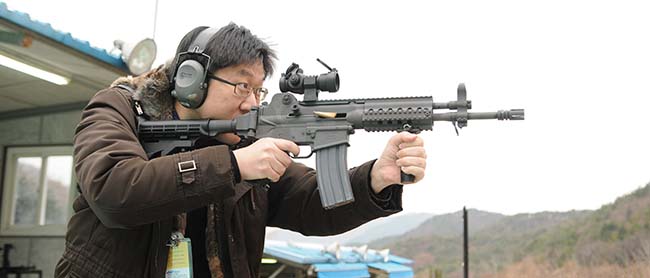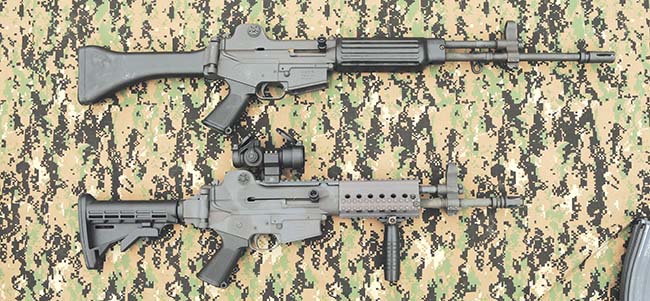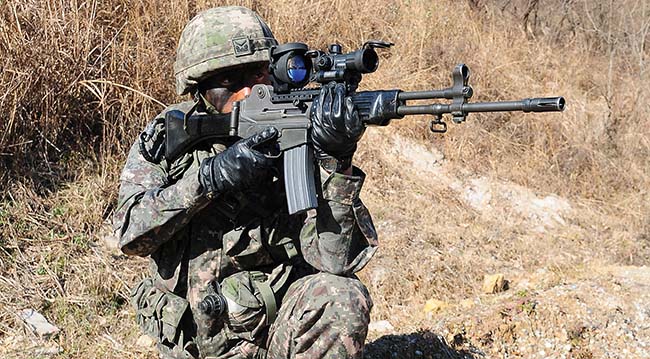ABOVE: K2C with BUIS, with stock fully extended. This gun is Cerakoated.
As many of our readers know, the K2 rifle and K1A “SMG” are the standard infantry personal weapons of the ROK armed forces. K1A is actually a 5.56x45mm carbine, but ROK Army nomenclature has always been that the K1A is an SMG. While these have been in service since around the early 1980s, there’s one surprising fact; they haven’t really been upgraded since adoption.
While there had been some very minor upgrades in the heat treatment method, or minor design changes of some parts, there have been no major upgrades, as have happened in the M16A1 to M16A2 or M16A2 to M16A4. In small arms, it is a very rare case of doing nothing, since almost all countries and manufacturers who can design and manufacture military small arms have gone through significant changes for their weapons designs during those years, especially after the 1990s when the US Army standardized the MIL-STD-1913 interface, the “Picatinny Rail.”
Even though their allies went with all those changes in small arms during last the 3 decades, both the Korean military and the manufacturer, Daewoo Precision as well as its successors, S&T Daewoo and S&T Motiv were surprisingly inactive during almost 30 years in terms of upgrading their rifles and carbines. Actually, all of these are the same company; they only changed names due to the change of management.
Of course there are reasons. First, the ROK Army, the biggest military buyer in ROK (of the 600,000 members of the Korean armed forces, the ROK Army has 500,000), was not interested in upgrading their small arms. As you can see by the numbers, the ROK Army today is still a Cold War style force like the US Army before the 1990s. They have spent huge amounts of money on artillery and armor, so the infantry’s share of the budget is not large. Since they are too much focused on war with North Korea, who are basically a 1960s remnant, modern infantry tactics and weapons have not seemed urgent. Thus, they just kept buying existing rifles and carbines, without seeking upgrades.
In those circumstances, manufacturer didn’t see the need for upgrades; ROK military had bought about 2 million rifles and carbines(including a license-built M16A1) since the mid-1970s, and that means Daewoo Precision and it’s successors had supplied on average 40,000–50,000 rifles/carbines per year, during all of that 40 years period. If you can sell those numbers for a few dozen years, and the buyer says nothing about upgrades, and you don’t need to worry about competition, what motivation is there to change?
Another reason for this inactivity in upgrades was the manufacturer’s situation. Daewoo Precision was originally a subdivision of Daewoo group, but during the late 1990s the Daewoo group crumbled and Daewoo Precision was sold to S&T Group, and changed its name to S&T Daewoo, then changed again into S&T Motiv. During these changes and management chaos, stable R&D was not an easy option.
First Attempt: Adding a Rail to Existing Weapons
But that doesn’t mean upgrading attempts were non-existent. Most of them were from Special Forces and the private sector. Special Forces of course felt the need to upgrade the K-series weapons, since they couldn’t put any new optics or accessories from foreign sources on their Korean-made weapons. Some very elite groups could buy rail-equipped foreign weapons like M4A1 Carbines or G36s, but the majority of those Special Forces have to use Korean weapons. They tried to find a solution for the problem, and a few companies in Korea developed add-on rail systems for the K1A and K2.
Such rails have been offered since the early to mid-2000s, and small numbers were used within special operation groups. But the numbers were quite small, and it wasn’t until 2013 when the ROK Army finally adopted standardized MIL-STD-1913 rail systems for both K1A and K2. Actually, the first rail systems for K series weapons were developed for the K1A. K1A has no interface for optics or other accessories, and since it’s a standard personal weapon of many Special Forces, a solution to attach optics on K1A had some urgency for those special units. Until 2013 many non-standard rails from various companies were supplied in small numbers to Special Forces, but in 2013, the ROK armed forces selected standard rails, because of the introduction of new Dot sight.

Korean Armed Forces Finally Decided to Adopt a Standard Red Dot Sight
The PVS-11K (despite the PVS nomenclature, it’s not a night vision system- it’s an ordinary red dot, with night vision compatibility only), was adopted around 2012-2013. But for that purpose, they needed to find an interface for attaching the sight on the weapons. They decided to buy a rail system developed by DI Optical, the Korean company who also developed the PVS-11K.
Actually, it was DI optical who was the most active rail developer in Korea. Since they tried hard to sell their optics (mainly dot sights) to military, they also had to develop rails, especially for the K1A. Now when they could sell the optics, they could sell rails with them.
The standard rail systems for Korean armed forces are two; K1A’s and K2’s. K1A’s is a four-side rail hand guard system (side and under rails are usually not used, but can be attached easily if necessary), which is attached to the weapon’s barrel nut and hand guard attachment bolt. But the K2’s is only a short rail on the upper receiver, since the K2 originally has an optics mount on its receiver to attach it. Also, unlike the K2, the K1A is used by Special Forces, so they probably felt the need for a more elaborate rail on their K1A carbines.
Both rail systems are now in use by both regular and special units around the ROK military.
Second Attempt—The K2C
While new rails for existing weapons were developed and supplied, there has been another attempt to upgrade the weapon itself, at least for the export market.
In 2012, S&T Motiv introduced the new K2C, or K2-Carbine. It was a necessity born from demand. As you can see, the basic K2 rifle and K1A Carbines became more and more obsolete after 2000- not only without provision for modern MIL-STD-1913 compatible accessories, but also with somewhat obsolete concepts, both weapons had flaws on their designs. The K1A is not only a bit large for the modern 5.56mm “PDW” concept, but it also can’t provide a stable platform for modern special operation carbines, with its short barrel length and very uncomfortable stock design. K2 is also somewhat inadequate for becoming a modern tactical carbine, not only because of the lack of a rail attachment, but also with its length, which is basically only slightly shorter (less than an inch) than an M16A1.
To handle these problems, S&T Motiv designed the K2C, which is basically a shortened version of the K2 rifle with a flattop upper receiver and 4-way rail hand guard. They not only chopped the barrel to 13.5 inch, they also shortened the gas piston, and adjusted the front sight height to the new barrel. The rear sight is their newly designed detachable backup sight, but a version which retains the original K2 rear sight is also manufactured according to one African customer’s order.
The original K2 stock can be selected, but until today, virtually all customers opted to use an M4 style retractable stock; while the stock itself is folded to the right side just like on the K2, this can also be length-adjusted to each operator, an especially useful feature when they are wearing body armor.
Basic operation and functions are unchanged; like the K2, this is using an AK-style gas piston, only shortened to the new barrel configuration. Since it’s a short barrel and long stroke gas piston operation, it’s a bit less controllable than other comparable weapons like the HK416, M4A1 or SCAR, but it’s quite reliable- also, since charging handle is attached to the bolt carrier directly, it’s relatively easy to clear malfunctions like an AK or SG550 series rifle.
Weight is 3.3kg with empty magazine, and length is 875mm when its stock is fully extended, and 570mm with stock folded; it can use most STANAG magazines. Rifling twist is 7.3inch/1, and K2C can use both SS109(NATO) and M193 ammunition.
While still not adopted by ROK forces—Special Forces are considering it now, but are still undecided due to the budget—some K2Cs were exported to foreign customers, including Iraq government forces; it’s even used by their elite division, but some of them were also captured by ISIS and unfortunately used against their original owners.
The Third (but Not Last) Attempt: K2C1
K2C was a step forward from the old K-series rifle/carbine configuration, but the problem for its adoption by ROK armed forces is the highly rigid—probably one of the worst in democratic countries’ military—bureaucracy and less than up-to-date state of mind. Even Special Forces are not free from such drawbacks.
ROK Army’s upper echelon didn’t like the idea of a short-barreled carbine like an M4 or K2C; most of them still have a 1980s small arms concept in their minds, when the M16A2 was still deemed an adequate infantry rifle and carbine length weapons (such as today’s M4 carbine) were not for general infantry but limited for vehicle crews or special operation forces. Also, since K2C is in fact one new type of weapon, which is in the middle of a K1A “SMG” and the K2 rifle, they deemed it would take considerable time and bureaucratic effort to adopt K2C as a “new” type of weapon. One more thing; the Army high-level commanders didn’t like the K2C’s lack of a bayonet lug.
So the K2C1 appeared; it’s basically a K2 rifle, retains most of the basic features, but with a new rail hand guard, flat top upper receiver and new M4-style adjustable length stock. To some degree, K2C’s features were used to upgrade the K2 rifle. It is now distributed to front line troops to replace the old K2 rifles they have had for many years. It’s still used only in small numbers, and in 2016 there was a complaint from some users that the hand guard became easily overheated; but the main reason for this was lack of a method to cover or hold the hand guard properly, such as using a rail-attached cover or the vertical foregrip. The manufacturer actually recommended using these methods when it was first supplied to the Army, but they refused since “Such things (especially a vertical fore grip) don’t comply with our current bayonet fighting training manual!”
One thing to be curious about is the handguard. The Korean Army is usually very sensitive on weapons and equipment weight, so the K2C1 doesn’t have side and under rails on the hand guard- they can be attached easily when needed, but instead of more modern, more lightweight, more space-saving and virtually open-licensed Keymod or MLOK design, S&T used somewhat old fashioned screw attachments. Why didn’t they choose more modern attachments? One can only wonder.
The author didn’t have any chance to fire the K2C1, but since it’s only a K2 rifle with some external changes, it shouldn’t be that different from the original. However, since the weight is a bit heavier than the original (3.684kg vs. 3.37kg), it should be slightly more controllable than the original.










